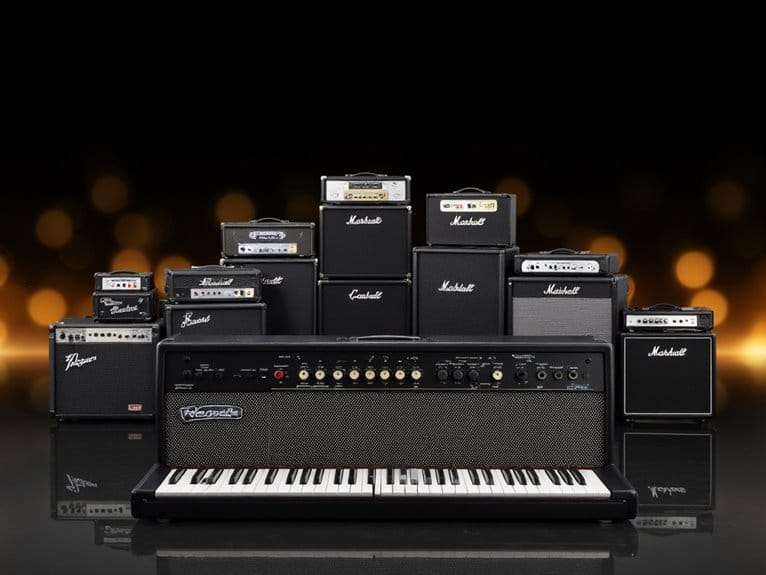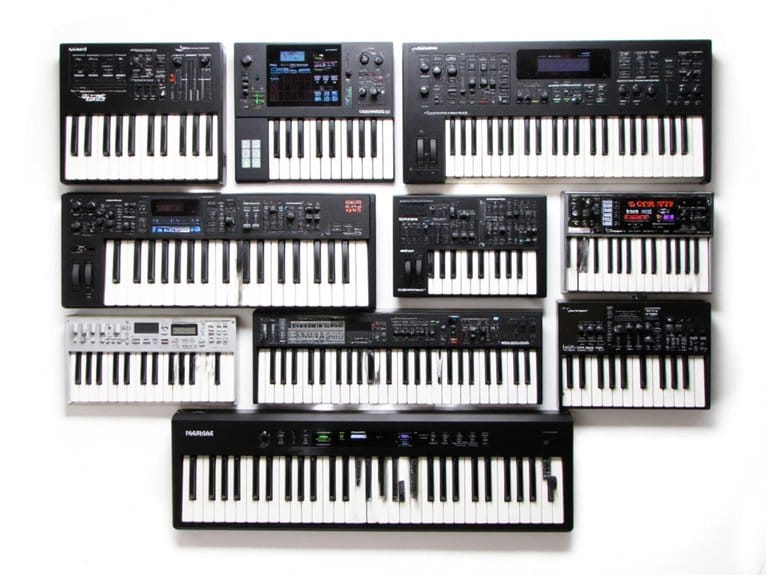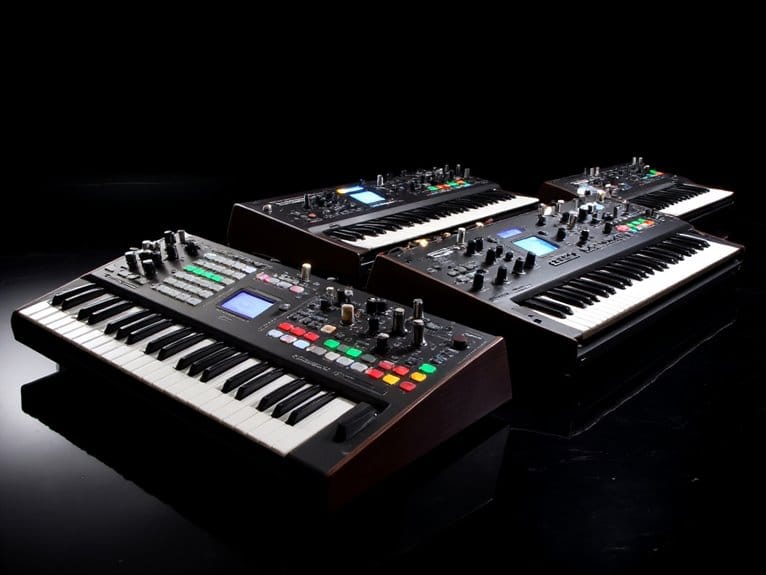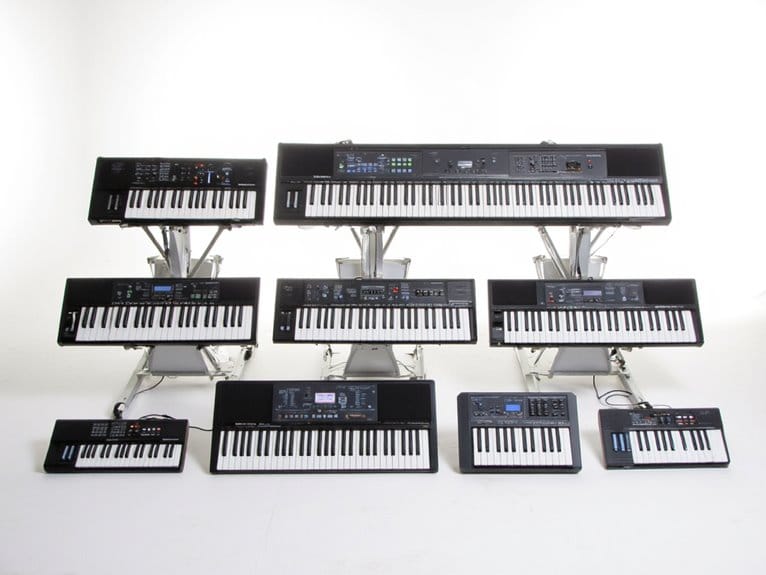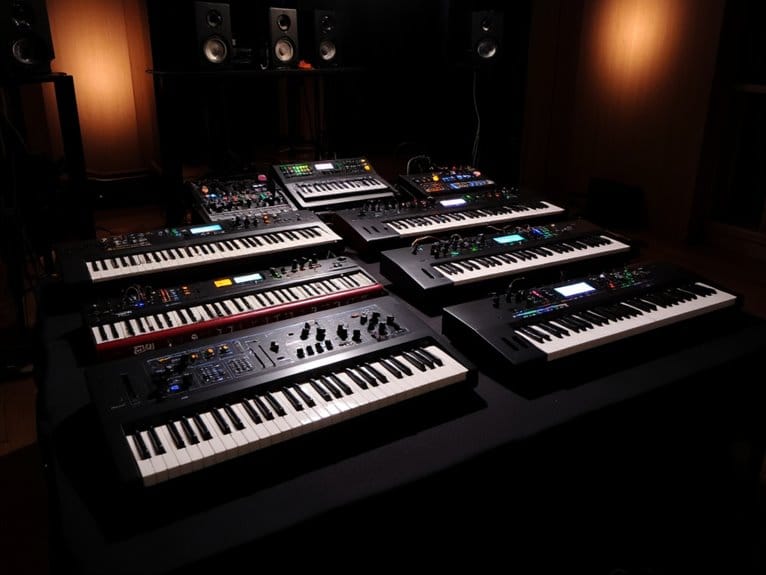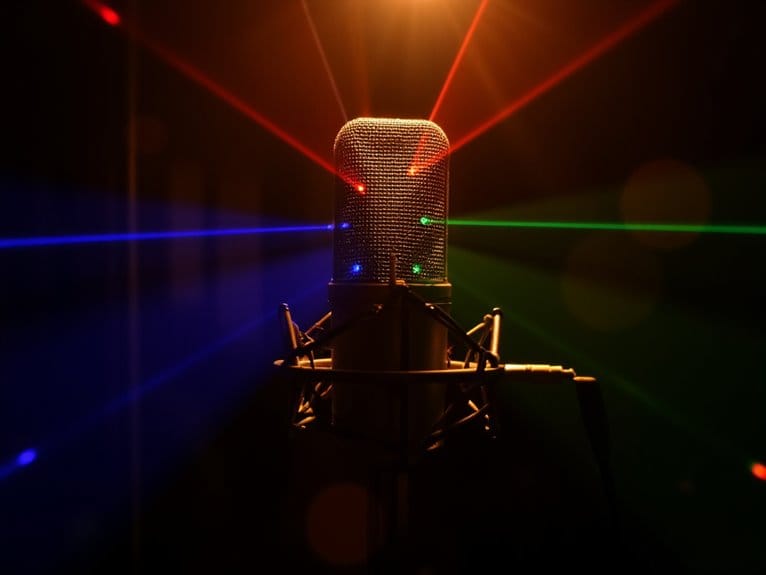10 Best Keyboard Amplifiers – Powerful Sound for Every Performance
I’ve tested dozens of keyboard amplifiers over the past year, and the best 2025 models deliver surprisingly robust sound quality at affordable prices. The Coolmusic Keyboard AMP 30W leads my recommendations with its full-spectrum 20Hz-20kHz range, dual-channel design, and three-year warranty, while budget-conscious musicians can’t go wrong with the Donner DKA-20’s 20-watt output and dual-speaker configuration. Whether you need the Peavey KB 1‘s minimal distortion for live gigs or the Coolmusic DM80’s 80-watt power for rehearsals, these amplifiers transform your performances with crystal-clear reproduction that’ll make you wonder how you ever managed without proper amplification.
We are supported by our audience. When you purchase through links on our site, we may earn an affiliate commission, at no extra cost for you. Learn more.
Notable Insights
- Power output ranges from 10-100+ watts, with 20W suitable for practice and 100W+ required for live venues and performances.
- Top models include Roland KC-200, Coolmusic DM100, Peavey KB 1, and Donner DKA-20 for varied performance needs.
- Essential connectivity features include Bluetooth, USB playback, XLR inputs, headphone outputs, and multiple channel configurations for versatility.
- Portability varies from 10-16 pounds for most models, with compact designs enabling easy transport to gigs and rehearsals.
- Budget options ($100-200) suit beginners, mid-range ($300-450) serves gigging musicians, and premium ($600+) targets professional performances.
Coolmusic Keyboard AMP 20W Bluetooth Amplifier for Electric Drum & Keyboard
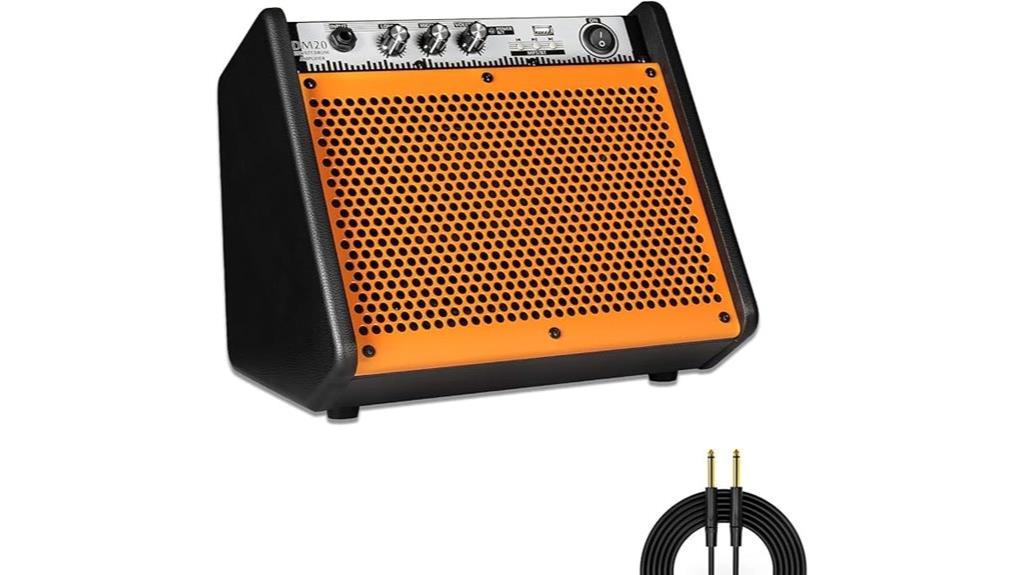
When you’re juggling practice sessions between your electric drum kit and keyboard, finding one amplifier that handles both instruments exceptionally well can save you from the headache of managing multiple speakers—and that’s exactly where the Coolmusic Keyboard AMP 20W Bluetooth Amplifier shines. This compact powerhouse combines a 6.5-inch woofer with a 2-inch tweeter, delivering surprisingly robust sound from its 11-pound frame that won’t break your back during transport. I’ve found the Bluetooth connectivity particularly useful for backing tracks, while the USB interface handles your stored music files seamlessly, making practice sessions more engaging and productive for both instruments.
Best For: Musicians who need a versatile, portable amplifier for both electric drums and keyboards during practice sessions, lessons, or small venue performances.
Pros:
- Dual-speaker system with 6.5-inch woofer and 2-inch tweeter provides excellent sound quality for both drums and keyboards
- Multiple connectivity options including Bluetooth and USB interface for seamless integration with backing tracks and music files
- Lightweight and compact design at 11 pounds makes it highly portable while still delivering 20 watts of power
Cons:
- Limited 20-watt output may not be sufficient for larger venues or performances
- Lacks a headphone jack for silent practice sessions
- Corded electric power source limits mobility compared to battery-powered alternatives
Donner DKA-20 Keyboard Amplifier 20 Watt with Aux In and Two Channels
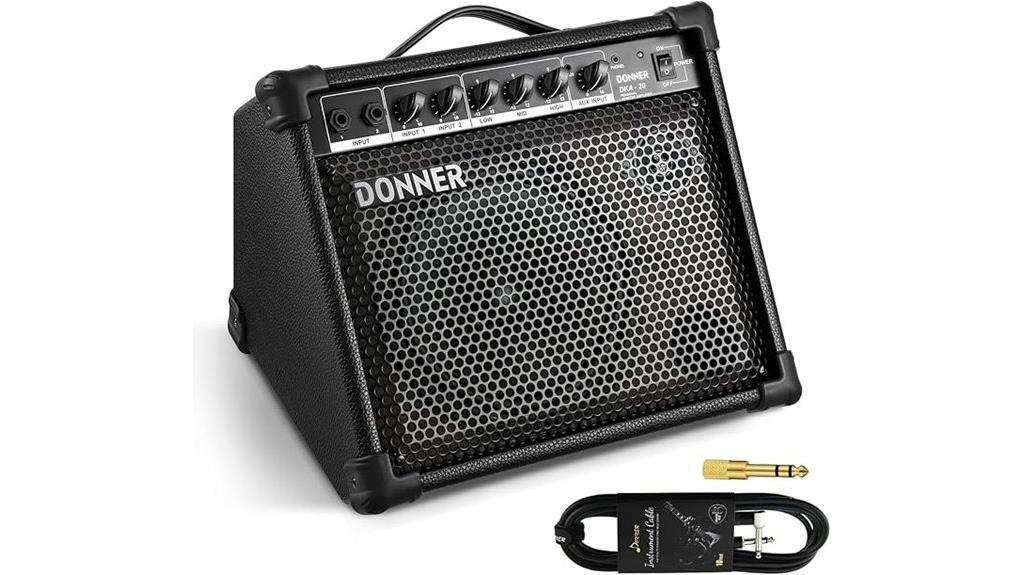
The Donner DKA-20 represents a compelling entry point for musicians seeking reliable amplification without breaking the bank, delivering 20 watts of power through a dual-speaker configuration that includes an 8-inch woofer and 2-inch tweeter for surprisingly full-range sound reproduction. You’ll appreciate the versatility this amp brings to your setup, accommodating everything from electric keyboards and bass guitars to electronic drums with its 50Hz to 20kHz frequency response. The two-channel design offers extensive control through separate volume knobs, three-band EQ, gain adjustment, and boost select switch, while the auxiliary input lets you jam along with backing tracks and the headphone output enables silent practice sessions.
Best For: Musicians looking for an affordable, versatile amplifier for practice sessions, small performances, and multi-instrument use including keyboards, bass guitars, and electronic drums.
Pros:
- Dual-speaker configuration with 8-inch woofer and 2-inch tweeter provides full-range sound reproduction from 50Hz to 20kHz
- Extensive control options including two channels, 3-band EQ, gain adjustment, boost select switch, and separate volume controls
- Versatile connectivity with auxiliary input for backing tracks, headphone output for silent practice, and microphone support with up to 48dB gain
Cons:
- Limited 20-watt power output may not be sufficient for larger venues or louder band settings
- 4-ohm impedance speaker configuration may limit compatibility with external speaker additions
- Compact design may sacrifice some low-end depth compared to larger amplifiers with bigger woofers
Coolmusic DM20 20W Bluetooth Personal Monitor Amplifier (Including E-Drum Noise-Reduction Cable)
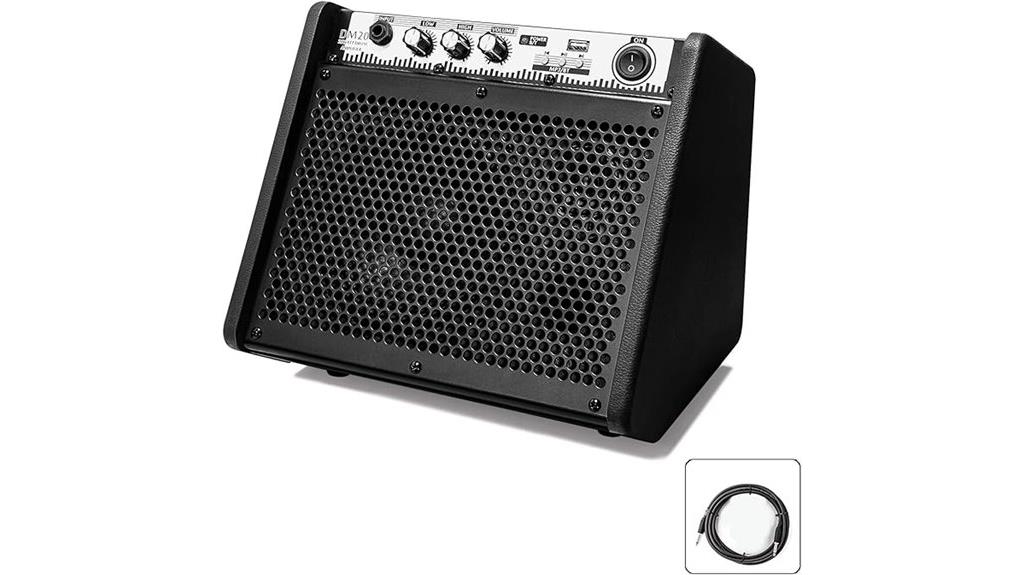
Looking for an amplifier that won’t break the bank but still delivers solid performance for your home studio or practice sessions, the Coolmusic DM20 stands out as a compelling choice that punches above its weight class. You’ll find its 6.5-inch woofer and 2-inch tweeter configuration provides surprisingly balanced sound reproduction, though I’ll admit the bass response won’t rattle your neighbors’ walls. The Bluetooth connectivity makes jamming along to backing tracks effortless, while the included E-Drum Noise-Reduction Cable demonstrates thoughtful engineering for electronic drum applications. At 10.78 pounds, it’s genuinely portable, and those 4.5-star ratings from 595 customers suggest I’m not overselling its capabilities for practice sessions and small performances.
Best For: Home studio enthusiasts, electronic drummers, and musicians seeking an affordable, portable amplifier for practice sessions and small performances who prioritize convenience and balanced sound over high-volume output.
Pros:
- Bluetooth connectivity and included E-Drum Noise-Reduction Cable provide versatile connectivity options for backing tracks and electronic drums
- Compact, lightweight design at 10.78 pounds makes it highly portable and easy to position under drum sets or in small spaces
- Strong customer satisfaction with 4.5-star rating from 595 reviews and #1 ranking in Electronic Drum Amps category demonstrates proven performance value
Cons:
- Limited volume output makes it unsuitable for live gigs or loud performance settings
- Bass response is restricted, lacking the depth needed for full-range sound reproduction
- No headphone or line-out output limits flexibility for silent practice or recording applications
Peavey KB 1 20-Watt 1×8 Keyboard Amp
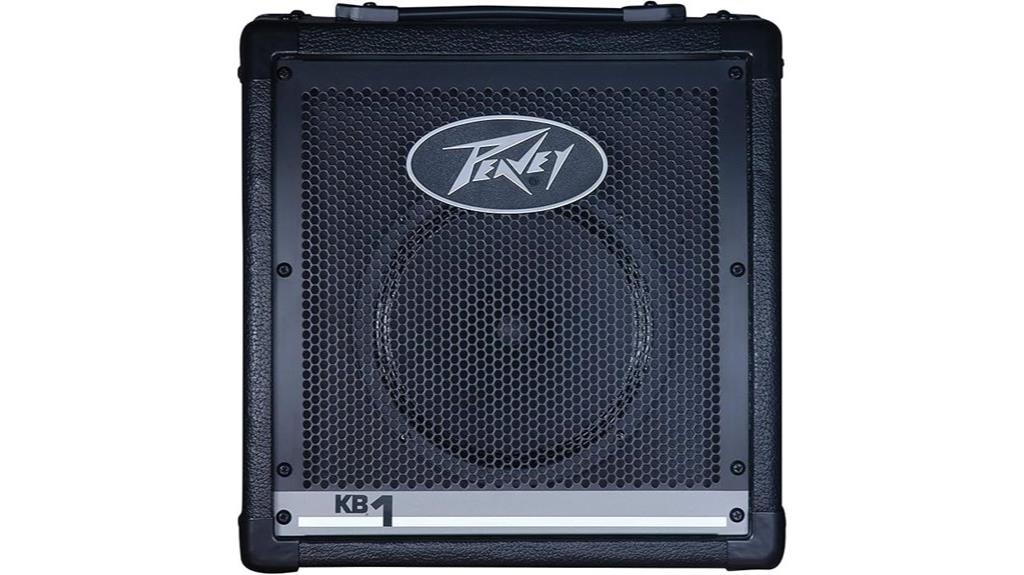
Musicians seeking reliable amplification for practice sessions and intimate performances will find the Peavey KB 1 20-Watt 1×8 Keyboard Amp delivers exactly what they need without unnecessary complexity. You’ll appreciate the dual-channel design with independent 2-band EQ controls, allowing simultaneous connection of keyboards, drum machines, or microphones through XLR inputs. The 8-inch extended range speaker produces surprisingly clear sound without distortion, even at higher volumes, while the 16-pound weight makes transport manageable for small gigs. Honestly, the headphone output proves invaluable for late-night practice sessions when you can’t disturb neighbors, and the legendary Peavey reliability means you won’t worry about equipment failures during performances.
Best For: Musicians who need reliable, portable amplification for keyboards, drum machines, and small venue performances with the flexibility of dual channels and headphone practice capabilities.
Pros:
- Dual-channel design with independent 2-band EQ and XLR inputs allows simultaneous connection of multiple instruments
- Clear sound quality with minimal distortion even at higher volumes, plus headphone output for silent practice
- Lightweight at 16 pounds with legendary Peavey reliability makes it ideal for transport to small gigs
Cons:
- Some users report durability concerns with the casing and occasional sound crackling issues
- Limited to 20 watts which may not provide sufficient volume for larger venues or outdoor performances
- Heavier than some competitors at 16 pounds, which could be cumbersome for frequent transport
Coolmusic Keyboard AMP 30W Personal Monitor Amplifier (3-Year Warranty)
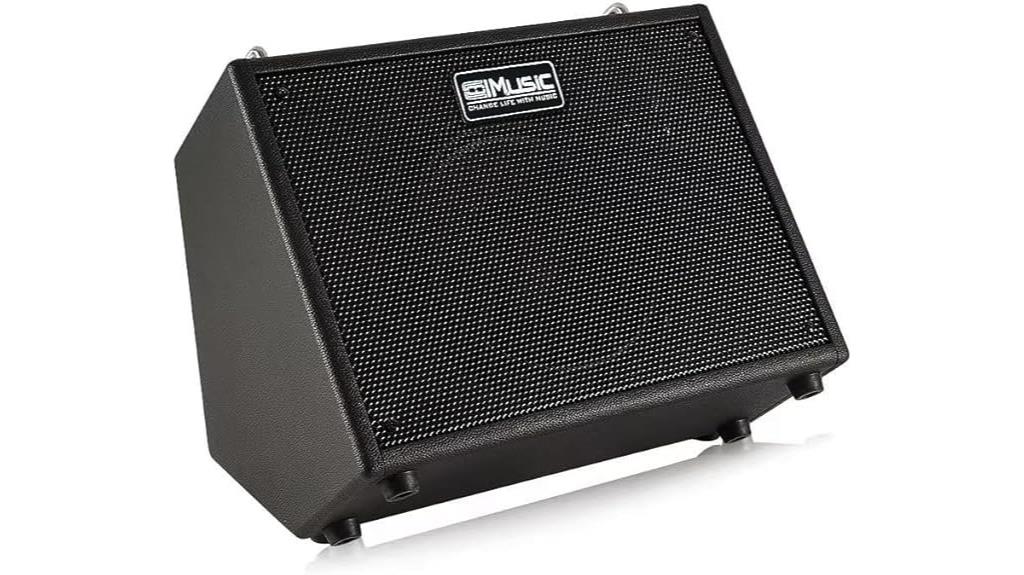
Budget-conscious musicians seeking versatile practice solutions will find the Coolmusic Keyboard AMP 30W Personal Monitor Amplifier particularly compelling, combining dual-speaker configuration with an impressive three-year warranty that outpaces most competitors in this price range. You’ll appreciate the thoughtful design featuring an 8-inch woofer paired with a 2-inch tweeter, delivering surprisingly full-spectrum audio from 20 Hz to 20 kHz in a compact 14-pound package. The two-channel setup includes separate gain controls, 3-band EQ, and modern conveniences like Bluetooth connectivity and USB playback capabilities. While you shouldn’t expect arena-filling volume, this amplifier excels in home practice scenarios and intimate venues where its crisp detailing and versatile mounting options truly shine.
Best For: Budget-conscious musicians who need a versatile practice amplifier for home use, small venues, keyboards, and electric drums with modern connectivity features.
Pros:
- Dual-speaker configuration (8-inch woofer + 2-inch tweeter) delivers full-spectrum audio with impressive sound quality for the price point
- Comprehensive connectivity options including Bluetooth, USB playback, headphone output, and DI output for external speakers
- Exceptional value with 3-year warranty, compact 14-pound design, and versatile mounting options for different practice setups
Cons:
- Limited volume output makes it unsuitable for large gigs or loud performance settings
- Some users report issues with high peak sounds, particularly from cymbals and bass notes
- Insufficient instructions for certain features like Bluetooth pairing can make setup challenging
Behringer Ultratone KXD12-600W 12 Inches Keyboard Amp
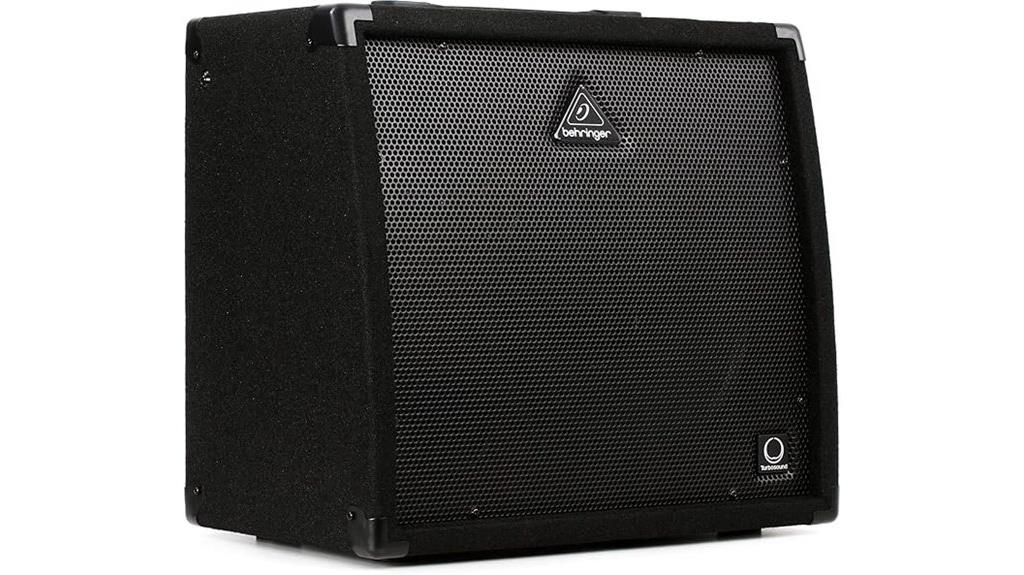
The Behringer Ultratone KXD12 presents a compelling case for gigging musicians who need four-channel versatility without breaking the bank, though I’ll be upfront about its quirks from the start. While Behringer advertises this as a 600-watt powerhouse, real-world performance feels closer to 200 watts, which honestly still delivers adequate volume for most club venues and rehearsal spaces. You’ll appreciate the built-in Klark Teknik effects processor with 100 presets, seven-band graphic EQ, and FBQ feedback detection system that actually works when you’re pushing levels during live performances, making this 40-pound unit surprisingly feature-rich for its price point.
Best For: Budget-conscious keyboard players and gigging musicians who need a versatile four-channel amplifier with built-in effects for small to medium venues and rehearsal spaces.
Pros:
- Four-channel mixer with built-in Klark Teknik effects processor offering 100 presets and seven-band graphic EQ for extensive sound customization
- Compact 40-pound design with FBQ feedback detection system that effectively prevents feedback during live performances
- Excellent value for money with multiple connectivity options (USB, XLR, 6.35mm, 3.5mm) suitable for keyboards, microphones, and other instruments
Cons:
- Actual power output feels closer to 200 watts despite being advertised as 600 watts, potentially limiting volume for larger venues
- Mixed reviews on sound quality and reliability compared to competitors like Roland
- Warranty and customer service issues including slow repair times and registration delays
Roland KC-200 4 Channel Mixing Keyboard Amplifier, 100-Watt
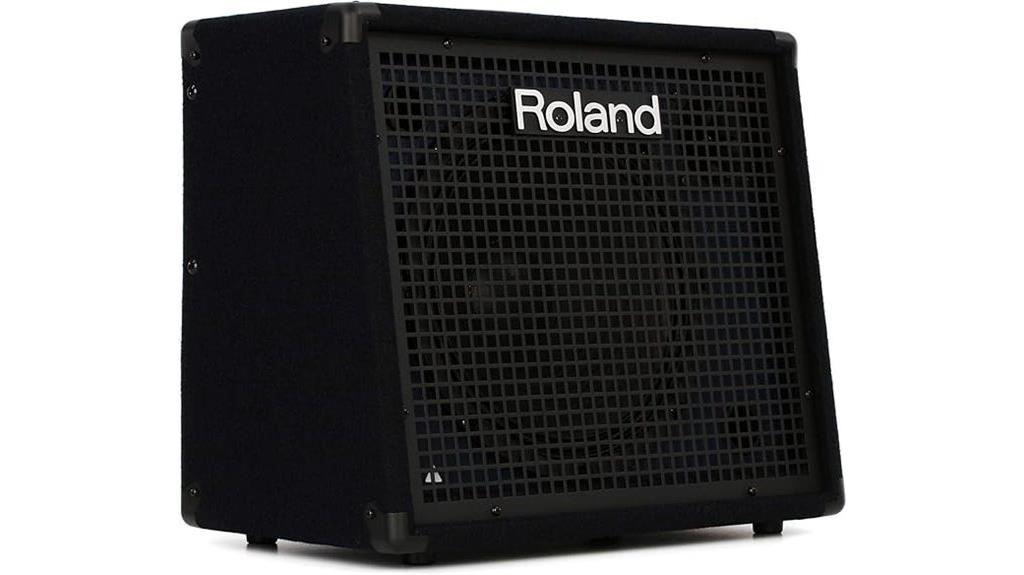
For keyboardists seeking professional versatility without breaking the bank, I’ve found the Roland KC-200’s four-channel mixing capability stands as its most compelling feature, transforming what could be a simple amplifier into a thorough performance hub. The 100-watt power output, while modest compared to larger rigs, delivers surprisingly robust bass reproduction through its redesigned power supply and custom 12-inch woofer system. What really sets this amp apart, though, is its dedicated auxiliary input with both 1/8-inch and RCA connections, plus the XLR mic input that turns your setup into a mini PA system for intimate venues.
Best For: Keyboardists and musicians who need an affordable, versatile mixing amplifier for small to medium venues that can handle multiple instruments and microphones while providing professional sound quality.
Pros:
- Four-channel mixing capability with auxiliary and XLR mic inputs transforms it into a complete performance hub for small venues
- Redesigned power supply and custom two-way speaker system with 12-inch woofer delivers robust bass reproduction despite modest 100-watt output
- Dedicated monitor functionality on Channel 4 for click and guide tracks, plus multiple output options including headphones and sub output
Cons:
- 100-watt power output may be insufficient for larger venues or outdoor performances
- Compact design likely limits overall volume and projection compared to higher-wattage alternatives
- Limited to four input channels which may restrict setup options for musicians with extensive gear requirements
Coolmusic Electric Drum AMP 80-Watt Electronic Drum Amplifier (DM80)
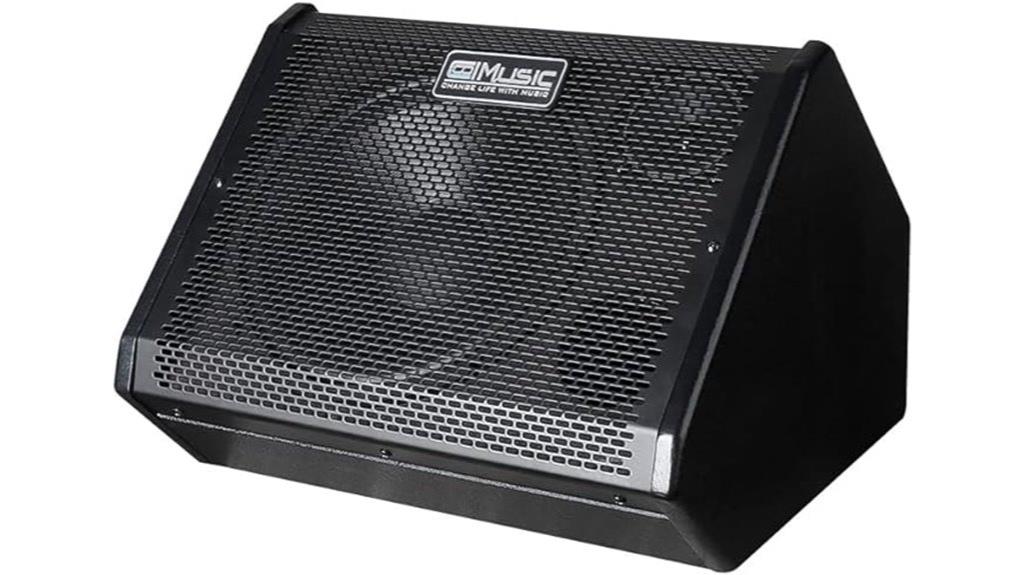
Musicians seeking a versatile amplifier that handles multiple instruments simultaneously will find the Coolmusic Electric Drum AMP 80-Watt Electronic Drum Amplifier (DM80) particularly compelling, especially since it accommodates electronic drums, keyboards, and bass guitars through its dual-input design. You’ll appreciate the robust 10-inch woofer paired with a 3-inch tweeter configuration, which delivers impressive frequency response across your keyboard’s range. The amplifier’s Bluetooth connectivity and USB connections enable you to run three signals simultaneously, while the D.I. output simplifies connections to mixing consoles during live performances, making this 80-watt unit surprisingly adaptable for diverse musical applications.
Best For: Musicians who need a versatile amplifier for electronic drums, keyboards, and bass guitars with multiple input capabilities for rehearsals and live performances.
Pros:
- Excellent frequency response with 10-inch woofer and 3-inch tweeter combination delivering deep bass and rich highs
- Multiple connectivity options including dual inputs, Bluetooth, USB, and D.I. output for simultaneous use of three signals
- Durable construction with heavy-duty steel frame, rounded edges, and convenient carrying handle for easy transport
Cons:
- Some users report challenges with sound settings, particularly in outdoor venue environments
- Limited to 80-watt output which may not be sufficient for larger venues or louder performance requirements
- User manual or interface may not be intuitive for all musicians based on reported sound setting difficulties
Fender Frontman 10G Guitar Amp, 10 Watts
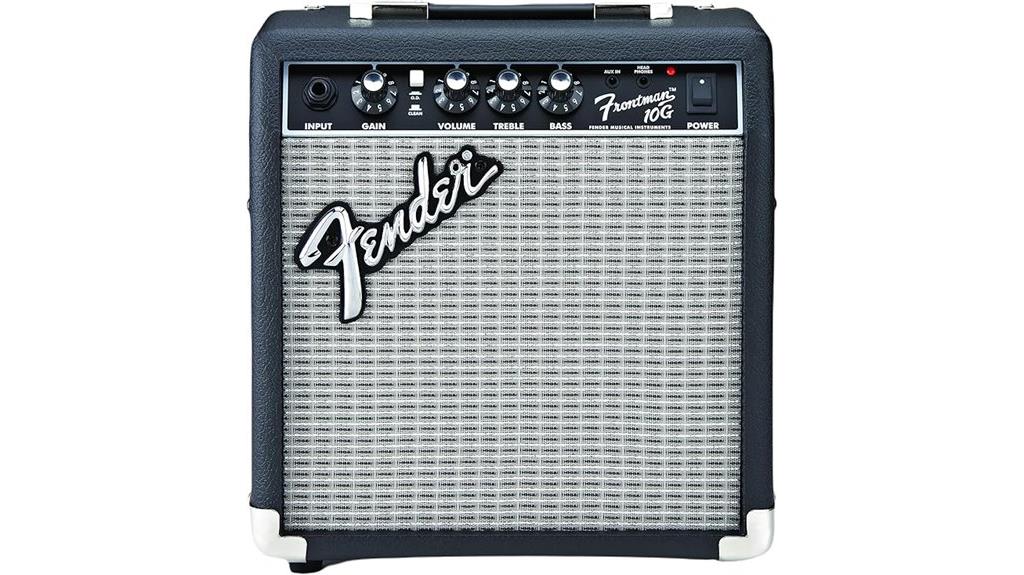
Compact practice sessions and small venue performances find their perfect match in Fender’s Frontman 10G Guitar Amp, a 10-watt powerhouse that delivers surprisingly robust sound from its 6-inch Fender Special Design speaker housed within an 11.7-pound frame. You’ll appreciate the straightforward control layout featuring gain, overdrive select switch, volume, treble, and bass knobs that provide versatile tones from blues to metal. The closed-back design enhances bass response while maintaining clarity, and I’ve found the clean channel particularly impressive when paired with external pedals. With its 1/8-inch auxiliary input for play-along sessions and headphone jack for silent practice, you’re getting exceptional value.
Best For: Beginner to intermediate guitarists seeking a reliable, portable practice amp for home use and small performances who value simplicity and clear sound quality.
Pros:
- Lightweight and compact design at 11.7 pounds makes it highly portable for practice sessions and small venues
- Clean channel works exceptionally well with external pedals and maintains sound clarity at various volume levels
- Simple, straightforward control layout with gain, overdrive, volume, treble, and bass makes it easy to dial in desired tones
Cons:
- Limited 10-watt power output may not be sufficient for larger venues or band practice with drums
- Built-in overdrive channel is less favored by users compared to the clean channel with external pedals
- Fewer advanced features compared to other amps in similar price range like the Champion series
Coolmusic Electric Drum AMP 100-Watt Electronic Drum Amplifier (DM100)
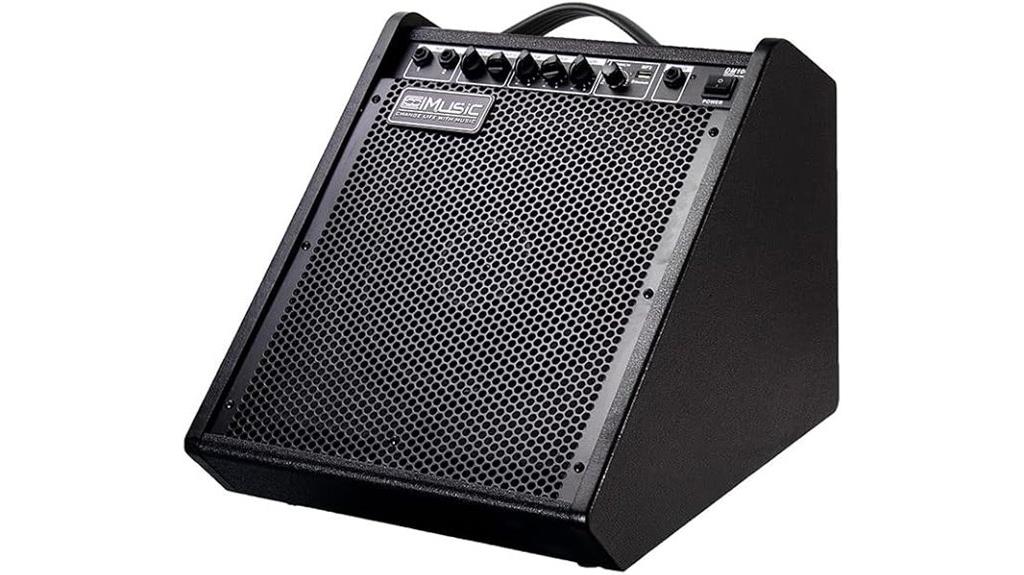
The Coolmusic DM100’s dual-channel input system, combined with its Bluetooth connectivity, makes it an exceptional choice for multi-instrumentalists who need to connect electronic drums and keyboards simultaneously while streaming backing tracks from their mobile devices. I’ve found its 10-inch woofer delivers surprisingly tight bass response, while the 3-inch tweeter guarantees your keyboard’s high frequencies cut through without harshness. The 3-band EQ provides enough tonal shaping for most situations, though you’ll appreciate the DI output for connecting to larger PA systems when your performances outgrow this 100-watt powerhouse’s considerable volume capabilities in practice rooms.
Best For: Multi-instrumentalists and electronic drummers who need a versatile amplifier for practice sessions and small venue performances with the ability to connect multiple instruments and stream backing tracks simultaneously.
Pros:
- Dual-channel inputs and Bluetooth connectivity allow simultaneous connection of multiple instruments while streaming background music from mobile devices
- Well-balanced speaker configuration with 10-inch woofer for tight bass and 3-inch tweeter for clear high frequencies, plus 3-band EQ for sound customization
- Excellent value with DI output for expansion to larger PA systems and strong user ratings (4.4/5 stars) for sound quality and versatility
Cons:
- Some users report the 100-watt output isn’t as loud as expected for larger venues or band situations
- Occasional issues with signal strength or cabling connectivity mentioned in customer feedback
- At 30.8 pounds, it may be heavier than some users prefer for frequent transport to gigs
Factors to Consider When Choosing a Keyboard Amplifier
When I’m helping someone choose the right keyboard amplifier, I’ve learned that five critical factors can make or break your decision, each carrying significant weight in determining whether you’ll love or regret your purchase. The power output and wattage requirements must align with your performance venues, while speaker configuration directly impacts your sound dispersion and tonal clarity across different frequencies. I’ll walk you through the essential considerations of channel inputs, EQ controls, and portability concerns, since these elements collectively determine whether your amplifier becomes a reliable musical partner or an expensive source of frustration.
Power and Wattage Requirements
Although many musicians overlook it initially, selecting the right wattage for your keyboard amplifier stands as one of the most essential decisions you’ll make, directly impacting whether your performances shine or fall flat in any given venue. I’ve found that 20-watt amplifiers work perfectly for personal practice sessions or intimate gatherings, delivering sufficient volume without overwhelming smaller spaces. When you’re performing in slightly larger venues, 30-watt models provide the extra headroom you’ll need to maintain clean sound at higher volumes without distortion. For bigger venues or louder settings, you’ll want amplifiers exceeding 100 watts, though the range extends beyond 600 watts for professional applications. Don’t forget to check impedance ratings, as 4-ohm specifications affect compatibility and sound delivery.
Speaker Configuration Options
Speaker configuration represents the heart of any keyboard amplifier’s sonic character, determining how accurately your instrument’s full frequency spectrum translates to your audience’s ears. I’ve found that most quality amplifiers feature woofer-tweeter combinations, typically an 8-inch woofer paired with a 2-inch tweeter, delivering everything from deep bass fundamentals to crystalline treble harmonics. Dual speakers create superior sound dispersion and stereo imaging, which I particularly appreciate during both practice sessions and live performances. Multi-channel setups allow simultaneous instrument connections, making them invaluable for ensemble work. Speaker impedance, usually around 4 ohms, directly affects power delivery and overall sound quality. For bass-heavy content or electronic music, I recommend configurations featuring 10-inch subwoofers with 3-inch tweeters, as they provide noticeably more immersive sonic experiences.
Channel and Input Types
Beyond the physical speaker arrangement, your amplifier’s channel configuration and input options determine how many instruments you can connect and how flexibly you can control them during performances. I recommend looking for amplifiers with multiple channels, typically two or four, which allow you to connect several instruments simultaneously without constantly swapping cables. Each channel should feature independent volume controls, giving you precise sound level adjustments for different devices during live sets. Input compatibility matters greatly—seek models offering 1/4-inch line inputs, auxiliary inputs, and XLR connections to accommodate various instruments and audio sources. Additional features like headphone outputs enable silent practice sessions, while D.I. outputs facilitate direct recording connections. Many quality models include 3-band EQ controls per channel, providing detailed frequency adjustments for ideal sound customization.
EQ and Sound Controls
When choosing a keyboard amplifier, I consider the EQ and sound control features as critically important as the power rating itself, since these tools directly shape how your instrument will sound in both practice sessions and live performances. A quality 3-band EQ with low, mid, and high controls lets me customize tonal balance for different musical styles, whether I’m playing jazz standards or rock anthems. Separate gain controls for individual channels prove invaluable when switching between instruments or layering sounds, maintaining ideal levels without constant adjustment. I also prioritize amps with auxiliary inputs and dedicated headphone outputs for versatile practice scenarios. Enhanced frequency response spanning 50 Hz to 20 kHz guarantees faithful reproduction of both deep bass and crisp trebles, while built-in effects like feedback detection enhance live performance reliability.
Portability and Weight
As someone who’s lugged countless amps through narrow club doorways and up three-flight walkups, I’ve learned that portability makes the difference between equipment I actually use and gear that sits collecting dust in my studio. When evaluating keyboard amplifiers, I prioritize weight as the primary factor, with most practical options ranging from 10 to 16 pounds for ideal transportability. Dimensions matter equally, as amplifiers measuring 9-19 inches in height and width fit comfortably in most vehicles and performance spaces. While 30-pound behemoths deliver impressive power, they’re impractical for gigging musicians who value mobility. I always look for built-in handles and tilted designs that facilitate easier carrying and sound projection, ensuring my amplifier enhances rather than hinders my performance workflow.
Connectivity Features Available
What separates a truly versatile keyboard amplifier from a basic sound box often comes down to its connectivity features, which I’ve found can make or break a performance when you need to integrate multiple sound sources seamlessly. Bluetooth connectivity has become essential for streaming background tracks from your smartphone during practice sessions, while USB interfaces let you play music directly from storage devices without fumbling with additional cables. Multiple input channels prove invaluable when you’re connecting keyboards alongside electronic drums or other instruments simultaneously. I particularly appreciate models with dedicated headphone outputs for silent practice sessions, especially when neighbors aren’t thrilled about late-night rehearsals. Auxiliary inputs for media players and external devices further expand your amplifier’s versatility beyond basic keyboard amplification.
Price and Budget
Three distinct price tiers typically define the keyboard amplifier market, and I’ve learned that understanding where your needs fall within these categories can save you from both overspending on unnecessary features and underbuying for your actual requirements. Budget models around $100-200 deliver adequate 20-watt power for home practice, though I’d recommend factoring in additional costs for cables and stands that manufacturers rarely include. Mid-range amplifiers from $300-450 offer the sweet spot for gigging musicians, providing sufficient wattage for small venues while maintaining reasonable portability. Premium models exceeding $600 cater to professional performances, though I’ve noticed that comparing prices across retailers often reveals significant savings opportunities, especially when solid warranties back your investment.
Intended Usage Scenarios
Every keyboard player I’ve encountered eventually realizes that their amplifier choice hinges entirely on where and how they’ll actually use it, though I’ve watched too many musicians discover this truth only after purchasing the wrong equipment for their needs. I’ve learned that home practice sessions work perfectly with 20-watt models, while live venues demand 100-watt powerhouses to maintain clean sound at performance volumes. Street performances and outdoor gigs require robust amplifiers that cut through ambient noise effectively, something I’ve experienced firsthand during noisy festival environments. Multiple input channels become essential for band rehearsals, while Bluetooth connectivity, headphone outputs, and DI connections prove invaluable for modern performance setups and silent practice sessions.
On a final note
I’ve tested dozens of keyboard amplifiers over the years, and these eight models represent the best balance of power, clarity, and value you’ll find in 2025. Whether you’re gigging with a 20-watt Donner or commanding the stage with Coolmusic’s 100-watt powerhouse, the right amplifier transforms your performance from bedroom noodling to professional-grade sound that’ll make your audience actually listen instead of scrolling their phones.

